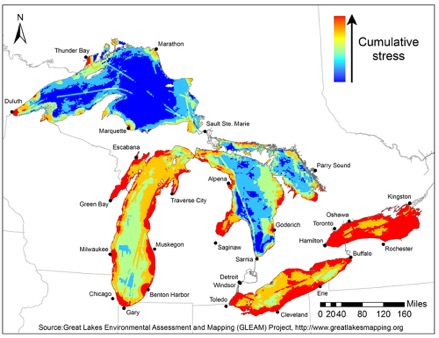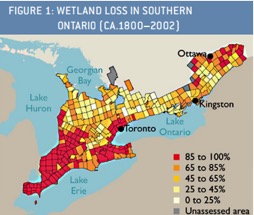
This blog is Part IV of a 5-part blog series, as part of our Biodiversity Video Campaign.
"Forests, wetlands and the watersheds they strengthen, are essential players in biodiversity and not only offer us a natural water filtration system, but are essential to the health of the natural environment."
Biodiversity Jenga
The success of ecosystems of any shape, size or type depends on the health of the resources that it relies upon. Ontario is home is a diverse collection of ecosystems, yet every year, more plants and animals are added to Ontario’s list of species at risk, which now numbers more than 200. Like a game of Jenga, if species are removed from the ecosystem like blocks from a Jenga tower, it will not take long until that tower collapses. With 38 per cent of Canadians living in Ontario, urban sprawl in southern Ontario is increasing at an alarming rate- which means forests and wetlands are being paved over, weakening the watersheds they support. However, the loss of forests, wetlands and watersheds will lead to severe biodiversity loss, which impacts the health of both human and non-human species.
Lake Ontario - the most polluted of the Great Lakes
Lake Ontario is home to and provides a source of drinking water to 9 million people living in Ontario and New York and more Canadians live on Lake Ontario’s watershed than another in Canada. This makes Lakes Ontario essential to the biodiversity in Southern Ontario and North-Eastern America. Among the five major lakes within the Great Lakes, Lake Ontario is by far the most polluted of the group, followed closely by Lake Erie.
According to the Lake Ontario Waterkeepers, the “greatest threats to Lake Ontario come from urban development, electricity generation, and sewage and storm water pollution.” The waters of the Great Lakes travel through Lake Ontario, which flow into the St. Lawrence River until they reach the Atlantic Ocean, and thus the pollution from other lakes is either deposited in Lake Ontario or makes it way into the ocean. The impact that we have on the Great Lakes, not only impacts our local communities and ecosystems in Canada, but impacts the water sources on a global scale.


Figure 1. Source: Lake Ontario Waterkeepers
One of the great ways to protect Lake Ontario is to bolster our support and protection of the watersheds that surround Lake Ontario by restoring, maintaining, and protecting the forests and wetlands that sustain watersheds.
Watersheds are better than Brita
A watershed is the area of land that catches snow and rain that drains or seeps into a marsh, stream, river, lake or groundwater. Watershed ecosystems form part of the natural infrastructure needed for water security. They help reduce water pollution by acting as natural sponges, filtering out pollutants. Watersheds can control the quality of water entering streams, rivers and lakes, a service of vital importance that would otherwise be performed by costly filtration plants. Pollutants such as viruses, oil, metals, excess nutrients and sediment are absorbed or filtered out of the water by soil and small organisms as it flows through forests and wetlands.
With that said, watersheds can only work their magic if they are supported and covered by healthy forests and wetlands. The Ontario government recognizes four types of wetlands in Ontario including: “bogs and fens, often called peatlands, which are common in northern Ontario; marshes, the most common type, are periodically or permanently flooded with water. They contain plants like cattails and water lilies; swamps are wooded wetlands, and they can be found across the province”.


Figure 2. Source: Ducks Unlimited Canada, 2010
According to the Sustainable Cities Institute, one of the major threats to watersheds are impervious surfaces such as highways and parking lots because they prevent water from soaking into the ground thereby increasing the amount of stormwater runoff flowing into streams, rivers, lakes, and wetlands. Urban environments that have an abundance of impervious surfaces often experience extreme flooding and erosion. Waterways surrounding paved surfaces are at risk to polluted runoff such as oil, grease, trash, and pesticides.
The power of forests and wetlands
A healthy watershed is highly forested or covered with wetlands. These environments offer permeable soils, filled with roots, and minerals that filter the pollutants out of water, and maintain a balanced water flow. Forests and wetlands are not just key players in water filtration for the environment, but they also offer shelter and food for wildlife such as birds, bats and frogs that lower the population of agricultural pests, and are also home to pollinators that germinate the crops, plants and flowers of nearby farms and gardens.
Forests and wetlands also act as a sink for carbon dioxide and greenhouse gases. The European Environmental Agency states that healthy soils can mitigate climate change by depositing carbon throughout the roots and within the surrounding soil. Wetlands, which cover around 9 per cent of the earth’s surface, are also great at capturing carbon and greenhouse gases, and studies suggest they devour 35 per cent of the planet’s carbon.
Forests, wetlands and the watersheds they strengthen, are essential players in biodiversity and not only offer us a natural water filtration system (which help save taxpayer dollars) but they are essential to the health of the natural environment.
Water policy acts in Canada
The Canadian government has three federal acts administered by Environment and Climate Change Canada that work to protect the water in Canada: The Canada Water Act, 2006, which contains provisions for formal consultation and agreements with provinces; the International River Improvements Act, which provides for licencing of activities that may alter the flow of rivers flowing into the United States, and; the Department of the Environment Act, which assigns the national leadership for water management to the Minister of the Environment.
The Great Lakes in Ontario are also protected by the Great Lakes Protection Act, 2015, Ontario’s Clean Water Act, 2006, and the Growth Plan for the Greater Golden Horseshoe, the Niagara Escarpment Plan, the Oak and Ridges Moraine Conservation Plan. Lake Ontario’s watershed which is located in the Greenbelt, is also protected by Ontario’s Greenbelt Act, 2005 and the Environmental Protection Act, 1990.
What can you do?
There are number of things that you can do at home to support your local watershed, and below you’ll find a number of suggestions:
1. Plant native species:
· Planting native plants and trees in your garden will support the water system that runs through your backyard, will prevent soil erosion, and will provide a shelter and food to local wildlife.
2. Avoid using pesticides:
· Embrace the weeds (they’re plants too!) or find none toxic ways to maintain your garden. Keeping pesticides off your lawn means less pollutants in your local watershed!
3. Avoid paving your driveway:
· Sticking to gravel is a great way to support permeable soils and prevent stormwater runoff.
4. Watch out for waste:
· Picking up trash or your pets waste is helps give your soils and waterways one less thing to worry about. Wildlife are often found dead with bellies fill of trash- so picking up that receipt or straw you accidently dropped could help save a life.
5. Support environmental organizations, such as the Sierra Club Canada Foundation, that are working hard to support nature and protect biodiversity.
6. Watch our “Biodiversity in Ontario” video to learn more about the importance of biodiversity in Ontario!
You can learn more about your watershed on the interactive maps provided here.
This article was written by Stephanie Hulse, Environmental Outreach Coordinator at Sierra Club Ontario.
